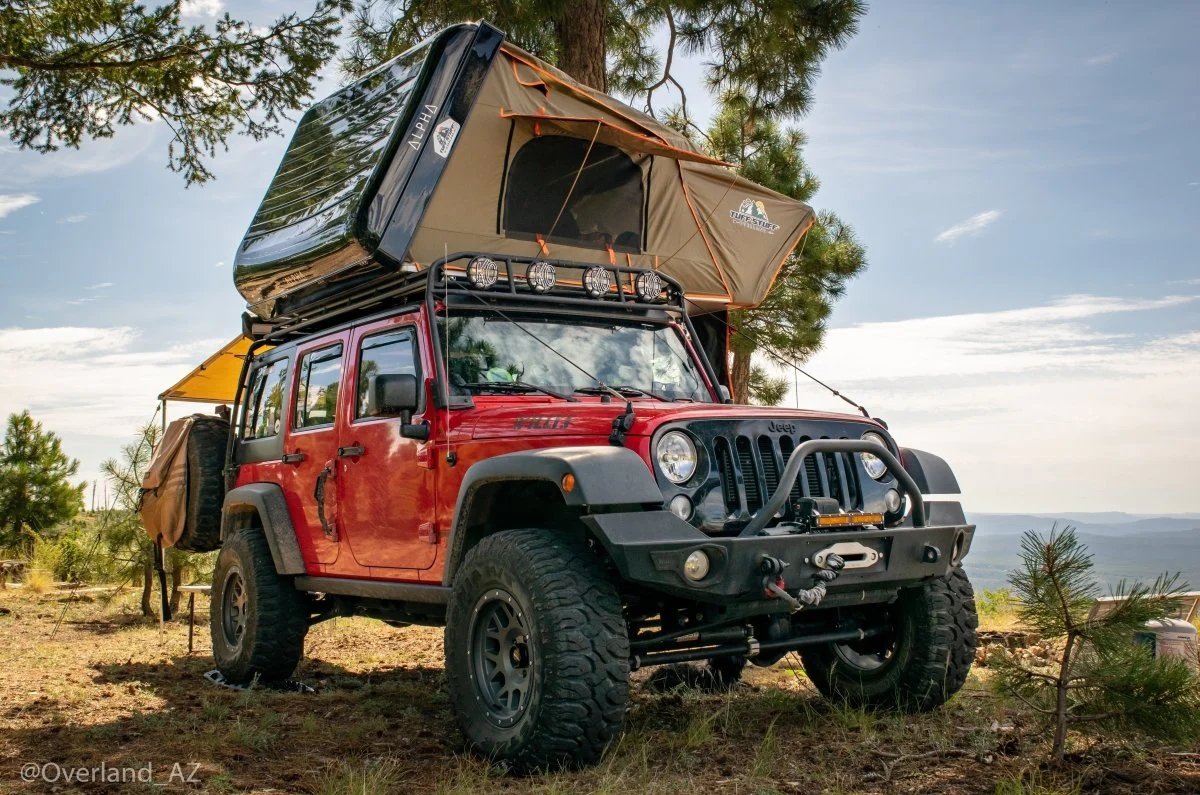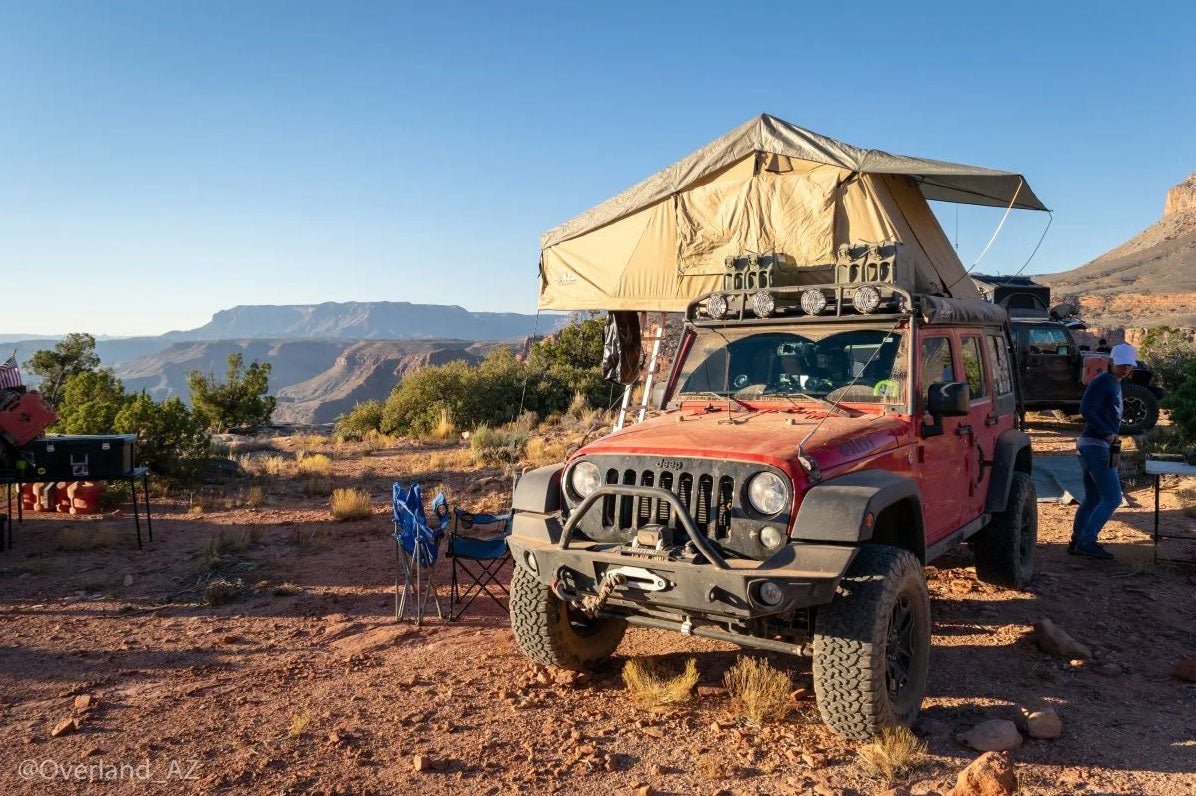As an outdoor lover who also doubles as a dog parent, going camping without your loyal furry companion is rarely an option.
While this means you will have an active, entertaining, and possibly fierce plus-one to enjoy the outdoor camping experience with, it also means you have to make extra preparations. If you use a rooftop tent, your biggest concern might be getting your dog in and out of your tent daily.
Getting your dog up the RTT ladder and into your tent might seem like a brain-racking puzzle that you do not have the answers to. However, in this article, we have provided the easiest way to get your dog in and out of your tent without any problem!
A Rooftop Tent And A Dog… Or Two
Rooftop tents are the innovative camping gear of the decade. These tents take the cake for their contribution to improving the quality of outdoor camping or overlanding by providing features that enhance convenience and comfort.
Rooftop tents are tents erected on the roof of a vehicle. With your tent latched to the top of your camping vehicle, you can camp anywhere, especially in terrains usually unfavorable for ground tents. This camp-on-the-go benefit allows campers-and their dog(s)- to be anywhere they want to be at any time.
Ordinarily, to use your rooftop tent, all you need to do is install it. After the initial installation, you can leave your tent on the roof of your vehicle, secured in its cover whenever it is not in use. When you arrive at a camping area or pull off the side of the rod, you simply have to erect it, a process that takes less than three minutes on average, attach the ladder, and climb into your tent.
However, with a dog, it might start to seem sketchy as you wonder how you are supposed to get your dog in the tent.
There are many great things about bringing your dog with you on your camping trip. Firstly, you will feel safer knowing you have a companion with sharp eyes and a powerful nose to alert you when predators are around.
Secondly, you have time to bond with your furry friend. Lastly, your dog will help you remain active in the wilderness, getting exercises as you take them on walks or play fetch with them.
While these are great, you have to worry about simple actions like getting your dog into your rooftop tent. With the magical act of levitation out of the equation, you are left with finding actual options that will work for you and your furry roommate.
How To Get Your Dog Into Your Rooftop Tent
Unless you have a magic carpet stuffed in the back of your truck along with other camping essentials, you will need a realistic solution to getting your dog in and out of your tent. Some of the best methods you can use include:
1. Just Carry Them
It makes sense, doesn't it?
The easiest answers are not always farfetched. The oldest trick in the book will be to carry them up and into the tent. If you already like lifting your dog into a hug, this should not be a problem.
Carrying your dog is the most realistic and straightforward solution to getting them into your elevated nest. All you need to do is grab them firmly yet softly across the middle and place them safely in the tent.
While this is great for small and nifty dogs, it might prove difficult if your dog weighs a lot. Although it might be more challenging, it is nothing strong arms cannot solve.
Admittedly, carrying a dog up a flight of stairs differs from carrying them up a ladder. Seeing that your hands will be full- especially if you have a big dog- one wrong foot placement and down you and the dog goes.
If you are camping alone, there is really no way to beat this problem. All you can do is ensure you grip your dog and ladder firmly to ensure both your safety.
If you have company, you can get someone to watch your back-literally. Have them stand behind you as you climb the ladder and provide support to prevent you from tripping or losing your balance.
You can also climb into the tent first and have someone lift your dog to you. If your partner is tall and can lift high enough, you can reach down to grab your dog without them having to climb the ladder.
If you have a low rooftop tent, you have less to worry about as you can simply lift your dog overhead without climbing the ladder.
Either way, you will get an arm workout out of doing this every day.
Pros of this method:
- Simple and effective
- No technicalities needed
- Free arm workout
Cons of this method:
- You may need a partner
2. Use A Vest Harness
A vest harness is another easy and effective way to get your dog into your rooftop tent. However, if you don’t already have a vest harness, you will need to purchase one.
Vest harnesses are a great option for bigger dogs where lifting them is not an option. It is a safer and more efficient method that saves you the arm workout while ensuring you don't trip on the ladder and hurt yourself or your pet.
Dog harnesses are multi-purpose, so they are a great investment even when you are not camping. They can be used to walk your dog, lift your dog into the car, carry your dog upstairs, and of course, carry or lift them up rooftop tent ladders. You can do all these without worrying about side effects like affecting your dog’s gait.
Dog harnesses are beneficial for many reasons. This equipment is great for assisting paralyzed or injured pets dealing with certain physical challenges, as well as helping dog owners keep their pets active outside.
With the support harness, you don’t have to constantly bend to lift your dog on the ladder whenever you go camping with them. This eliminates the back pain that comes with lifting heavier dogs and reduces the risks of hurting your dog when you pick them up by evenly distributing the pressure when you lift them.
Although there is still a level of physical effort needed when you use a dog body harness, it is better and safer.
There are different types of vest harnesses, so you need to purchase the one best for your dog and their disability (if any). Also, harnesses come in different sizes, so you need one that is not so small that it squeezes your dog and leaves them in constant discomfort or big that it allows them to wiggle out.
Keep the harness snug so your dog can perform normal activities like urinating and defecating without feeling restricted. Like a leash, a vest harness can take time to get used to, so it is important to introduce it to your dog slowly. Use treats and positive reinforcement to get your dog to adapt to the harness and ensure they remain relaxed.
Unless you plan on totally lifting your dog with the harness, it will help if you train them to climb the ladder while you pull on the vest. This combined effort reduces the effort you otherwise need to invest in lifting your dog and makes it easier.
Pros of this method:
- Easier on the arms
- Safer than lifting
Cons of this method:
- You will need to buy a vest harness if you don’t already have one
- You will need to train the dog to adapt to the harness
3. Use A Ramp
If you want your dog to be able to go in and out of your rooftop tent without you necessarily lifting them, you should consider investing in a ramp.
A ramp is a practical solution that will help your dog in and out of your tent easily. You can order a ramp that fits your tent from an RTT manufacturer or use DIY methods to make your ramp from scratch.
A rooftop tent ramp might be expensive but consider it an investment for subsequent camping trips with your fur babies. These ramps come as heavy-duty, durable fabric and clamps attached to a rooftop tent ladder to support the weight of larger dogs and guide them safely to the tent.
After you purchase the ramp, you can install it on your ladder and put the bottom of the ladder on a gearbox or any other sturdy object to lower the incline and make it easier for your dog to climb.
If you cannot spare the extra hundred dollars necessary to purchase a dog ramp, you can make one using strong plywood or rolls of carpet.
If you are using carpet, you will camp the carpet to your ladder firmly using ropes and carabiners or any other firm option. Afterward, it would be best if you raised the bottom of the ladder to reduce the angle of descent and make it easier for the dog to climb.
You can leave it attached at the top while allowing the carpet to roll up at the bottom easily. This will make it easier to switch your ladder between dog and human modes.
If you plan to use plywood instead, you will need a sturdy piece of plywood wide enough for your dog to climb on and long enough to provide a low slope, especially if you use a high rooftop tent.
You will also need double-sided sticky tape or anti-grip tape to provide traction and stop your dog from slipping off the makeshift ramp every time they climb it. Plaster the tapes on the plywood about six inches from each other to provide enough grip.
After you fashion your ramp, you will put your ladder at a less steep angle by placing the bottom of the ladder on a log or sturdy box. Afterward, place the makeshift ramp on top of the ladder and guide your dog up.
While this is great, you will always have to pack up your plywood whenever you go camping. It will also require effort to make the ramp and train your dog to use it.
Pros of this method:
- Less arm work as you do not have to lift the dog
- Convenience
Cons of this method:
- Extra bucks needed to buy a ramp
- Efforts to train your dog to use the ramp
- Action needed to make a DIY ramp
- Requires more space if you are going to pack plywood.

4. Train Your Dog To Climb The Ladder
Dogs are enthusiastic little creatures that always manage to climb into spaces that will catch any owner off-guard. Why not take advantage of their high spirits and train them to climb your rooftop tent ladder and get in and out of your tent without help?
Chances are, if your dog sees you coming in and going out of the tent many times, they will be encouraged to do so. This feat will be easier if your dog has previously used a vest harness for support to climb the ladder into your tent. With a little more training, you can ditch the harness and proudly watch your dog go up and down the ladder.
Of course, you will still need to raise the bottom of the ladder to ensure it isn’t set to a steep incline. Using the previously mentioned methods of placing a log, suitcase, gearbox, or any other sturdy option under your ladder to reduce the angle of descent will help your dog adapt to climbing easily.
If you are using a lower tent, you probably do not have to worry about reducing the ladder’s incline.
Admittedly, training a dog is easier said than done. The process can be entirely frustrating, as much as potty-training a three-year-old child. However, with time, treats, and lots of patience, you should be able to get your dog to ascend and descend the ladder without any problem.
The process can also be used to strengthen your dog. Who knows, you might get them to learn more tricks for your subsequent outdoor camping trip. When your dog finally learns the art of going up the tent ladder all by itself, you will have one more trick to show your friends and family!
This method of getting your dog up the stairs sounds great, but it won’t be an excellent option for disabled dogs as they will require assistance. Regardless, dogs are enthusiastic creatures, and with proper encouragement and training, you can teach your dog to climb up to the tent and back down.
Pros of this method:
- Helps your dog become independent
- No carrying involved
Cons of this method:
- Requires time and patience
- Not a great idea for disabled dogs
Why Rooftop Tents Are Great For Dogs
Except for the minor inconvenience of getting your dog up into the tent and down back- especially for bathroom breaks- rooftop tents are a great shelter for dogs as much as they are for humans.
Think about it. Not only will you feel safer keeping your furry companion close to you, but you will also keep your dog safer.
If you do not want to keep your dog in the tent with you, your only other option will be to keep it tied to a tree, in your truck, or the bed of your truck. However, these come with several concerns.
Keeping your dog leashed to a tree trunk will ensure it doesn’t wander off. While this is great, it also means your dog is exposed to cold and predators throughout the night.
Keeping your dog in your truck also sounds like a great plan until you forget to come down and let them out for a leak, only to wake up to a mess made on your precious car seats. You also have to deal with the dynamics of how far down the window should go so it doesn't get too cold and your nimble dog doesn’t get enough window space to wriggle out.
The truck bed is a tangible option, but you have to pad it down to ensure your dog doesn’t get cold and provide enough security to ensure your dog doesn’t wander off.
Why go through all these when you can bring your dog up to bed with you like you probably do at home?
Many rooftop tents are animal friendly and have enough weight capacity to support you and your dog without any problem comfortably.
With rooftop tents, you can ensure you and your dog stays comfortable. An elevated sleeping area means a flat surface without rocky bits poking you, no problems for you or your dog when it rains, and no cold spots on the floor.
With a rooftop tent, you and your dog will enjoy a good night's rest. At the end of each camp day, everyone is happy.
Getting Doggo Up And down The Tent With Ease
Rooftop tents offer many advantages, especially providing your dog the protection it needs on your trip. Bringing your dog to join you in your rooftop tent might seem like extra work on your camping trip. However, the benefits outweigh the cost, especially considering the companionship you will enjoy.
Figuring out the best way to get your dog in and out of the rooftop tent will require trial and error with different methods. Irrespective of how challenging this might seem at first, sooner or later, you and your dog will settle into a hitch-free routine.
To ensure you and your dog remain comfortable, invest in the best rooftop tent you can get.
(credit to @thecheesydoodles on Instagram for our main image)



